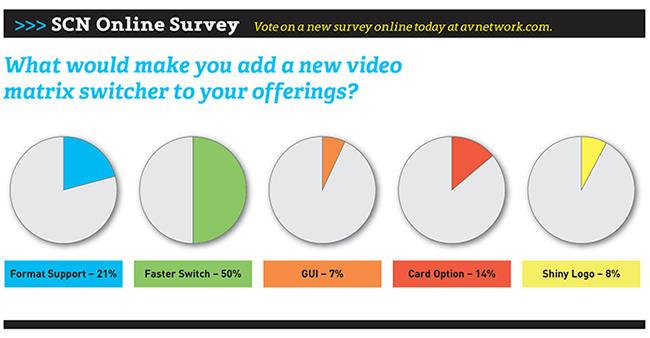How are integrators now distributing AV differently than we would have guessed five years ago?
* DigitalMedia provides the backbone infrastructure for distributing high quality, uncompressed HD digital video and audio. We’re seeing a wide adoption of streaming solutions. Streaming solutions offer more collaboration among organizations, real-time feedback, and can distribute content over a secure network. Crestron’s soon-to-be released AirMedia solution plugs in and seamlessly extends the DigitalMedia network to encompass wireless streaming connectivity to all mobile devices. This technology enables a presenter to simply connect his or her laptop or other mobile device over the local Wi-Fi network and begin displaying content through the room display. There are no wires to hook up, and no complicated settings to configure. Just walk into the room, follow the on-screen instructions, and click “play” to start presenting. This makes BYOD a seamless and intuitive experience for corporationsl. —Justin Kennington, Crestron DigitalMedia Technology Manager
* At FSR, we have seen a change in the way the integrators are distributing video. In the education market, there is a shift away from the traditional classroom where the instructor stands in front of the class. Matrix switches are being used to route video to multiple display points in the room. This allows both the teacher and the student to present from anywhere in the room. This increases student involvement in the learning process. —Chaz Porter, Regional Sales Manager, FSR
* Up to five years ago, the AV industry was working with mostly analog sources, such as VGA and component, and now the challenge of digital sources, such as HDMI, have arisen. We are faced with certain challenges for distributing and extending HDMI sources. With new products on the market, system integrators can distribute and extend HDCP compliant sources to much longer distances. HDBaseT is especially useful, as it handles both video and control signals, such as ethernet, RS-232, and IR. —Thomas Tang, President, Apantac
* One of the most significant challenges facing AV matrix switchers and distribution integrators in today’s market is dealing with the wide range of digital formats and how to handle content protection. Before HDMI and DisplayPort, it was a fairly easy install for matrix switchers and distribution gear. Analog did not include the current HDCP found in the latest digital sources. Today, HDMI could become your worst nightmare if you don’t understand how your equipment handles HDCP. Content protection is a major issue when trying to share multiple sources and displays via a switcher package, so integrators must be able to understand the basics of how content protection plays with all of the connected devices. —Chani Shah, COO, IHSE USA
* Five years ago, we were entrenched in an analog world, and within the last 12 months we have gone totally digital. The problem is, with all of its promise, digital has actually complicated system design and deployment. There is a “relearning curve” now in our pro AV business, and the
hardest group to reach is the installers because they are so busy, they can’t come out of the field to learn the nuances of digital signal routing, and that presents a catch 22. It is costing money at the job sites to troubleshoot the problems that would not be presenting themselves if we could reach the installers with the education necessary on the new digital technologies they are now installing. Also, streaming is coming on strong lately in larger applications where a network type switch is even being chosen as an option over both analog and digital video signal routing. —Clint Hoffman, Vice President of Marketing, Kramer Electronics
* There have been several unexpected developments in AV signal distribution over the past five years. First, there was the surprisingly slow adoption of HDMI, DVI, and DisplayPort interfaces, as well as the good distribution performance of Cat-5e cables. I believed that bandwidth requirements would have led to wider use of Cat-6 cable, perhaps even fiber. I am equally surprised that more display manufacturers have not adopted a standard for long distance inputs such as HDBaseT or fiber optic inputs, and am amazed that an IP standard such as AVB has not been more broadly adopted. Also intriguing is the fact that commercial AV is so far behind residential AV systems in these areas, although it’s clear that residential installers would not have switched had it not been for HDCP requirements on copy protected material. —Bill Schripsema, Commercial Product Manager, Atlona
* Today we have a better, more systematic approach to signal distribution. With the emergence of technologies like HDBaseT and video over IP, we have been able to integrate signal extension and switching into the same hardware frame as matrix switching. That’s probably one of the most exciting developments over the past few years: the ability to have a single enclosure that can swap out inputs and outputs with extension modules, so you have matrix switching and signal extension in one enclosure. Video over IP offers the ability to use IT solutions, such as a gigabit ethernet switch in a variety of sizes, with Gefen’s multi-format send/receive system, using packetized data as the transmission method. So you could say the manufacturers have begun to integrate their own offerings in order to better meet the needs of integrators. —Hagai Gefen, President, Gefen
* In the past, most AV systems consisted of several independent sub-systems—typically one for video, another for audio and another control, etc. Today we’re moving toward fully integrated systems where video, audio, ethernet, control, and even USB are all managed within the scope of a single AV distribution system. Such systems will become commonplace in the years ahead and will enable system designers to deliver much greater power and flexibility to their customers. —Steven Barlow, President, DVIGear
* Since the introduction of HDMI, the connection of digital AV sources and displays has been more convenient; however, it is no secret that HDMI cables presented integrators with significant challenges when trying to maintain signal integrity and a secure connection within large-scale systems over long runs. Today’s higher speed and locking cables have helped, but the integration of HDBaseT technology into matrix switching products has truly provided integrators with a dramatic improvement for both audio and video distribution. From increased reliability, to greater flexibility in design and planning, to a more simple installation, it is exciting to see how integrators today benefit from end-to-end system solutions that quite simply work. —Mark Dziekan, National Sales Manager, Wyrestorm
* Integrators are increasingly tasked with distributing HDCP-protected content video from Blu-ray players—so much so that HDCP support is absolutely required on matrix switches. Another thing we’re seeing is tighter integration and control. In conference rooms, for example, customers want a single media control system for everything, not only projectors, projection screens, and motorized window blinds, but also switches that support external control over RS-232 or ethernet. And in control rooms, customers want a single platform for matrix switching and distribution that can be controlled by multiple users, even those in remote locations. As a result of this change in the market, we now provide more integrated solutions, such as those that incorporate matrix video and peripheral switching with HD video distribution and remote workstation access. —Erik Indresovde, Global Video & Multimedia Product Manager, Black Box
* Five years ago, we anticipated the steady shift from analog to digital signals and from coax to fiber and twisted pair cable. Looking forward, higher video resolutions, refresh rates, and color depths continue to drive the need for additional bandwidth, so it’s critical that today’s switching systems incorporate a modular design that will support these future requirements. —Joe da Silva, Director of Product Marketing, Extron Electronics
* The integration of control, audio, high-resolution video, and data signals over Cat-x was perhaps envisioned by some, but not many. Due to the lack of a single standard, the extensive use of fiber and Cat-x extenders has caused a lot of grief, especially when EDID and HDCP are added to the mix. The speed of proliferation of mobile computing devices, including laptops, tablets, and mobile phones is another factor that was not expected. Many more integrated multi-room jobs versus more single stand-alone rooms have substantially increased the complexity of installations. As energy costs continue their inexorable march upward, operating efficiency assumes a more important role in total cost of ownership calculations. [Lastly,] wireless has not become as dominant as many had expected. —Tony Spica, VP Sales, RGB Spectrum
* HD was the top end of the AV space five years ago, and the thought of having to engineer and build 4K/UltraHD projects was not on the radar. As the consumer and pro AV spaces merge closer in terms of available equipment, systems integrators have to stay on top of the emergence of the 4K technologies becoming available. The transition to 4K is moving much faster than HD did in its infancy, and the price challenges and product form factors will not be as much of an issue in the new 4K products. The new 4K products create the opportunity for enhancing every live viewing experience with larger and even higher quality than could would have been discussed five years ago. —Bob Caniglia, Senior Regional Manager, Eastern North America, Blackmagic Design
* Five years ago, integrators were distributing analog AV more than digital. Even then, Cat-x cable helped to get the signal from point A to point B, but with degradation of the signal. Now most integrators are switching to HDMI, but still using Cat-x cables to deliver the content. The biggest difference is the quality and the capability. Utilizing technologies like HDBaseT allows us to go 625 feet at 1080p 60Hz 24bit with RS-232, IR, and LAN over a single cable in digital quality. In addition, we can even power the remote devices over the same cable. In turn this makes installations cleaner and quicker to install, especially since the digital extenders do not require gain control or equalizers like the analog Cat-x extenders. Our biggest selling matrix card is HDBaseT Cat-x extender input and output cards. —Paul Harris, CEO, Aurora Multimedia
* The trend we have seen with Lightware products is more signal types being sent down one cable at greater distances. Using twisted pair as an example, we carried DVI signals extenders that used one Cat cable for extending DVI signals. When we introduced the HDCP-compliant and HDMI extenders, they required two Cat cables for video, embedded audio, and optionally, power. —Drew Taylor, Applications Engineering, Lightware
* In recent years, there have been many breakthrough changes in AV distribution and the way facilities are designed. Five years ago, using fiber for connections between a central equipment room and a conference room required multiple boxes and converters on each end of every circuit. Now, systems integration is trending toward compact, centralized, ‘all-in-one’ solutions that are more cost-effective and easily configurable. Twistedpair cabling, cross-platform switching, HDBaseT, auto-scaling with seamless switching, audio breakout and down-mixing, and modular design are some of the key advancements in matrix routing technology. —Christine Park, Marketing Manager, Purelink

